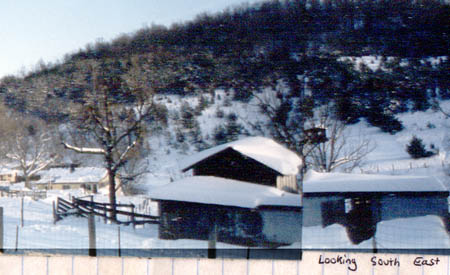|
|
|
trans-generational significance of barns
Wednesday, August 9 2006
I grew up in rural Virginia, in a life complete with forest, fields, livestock, gardens, streams, a swamp, and a barn. All were great settings for childhood play. But for my parents, the barn that was the space ships of my childhood was a large tool where form very much followed function. Parts that weren't absolutely necessary soon fell into first disrepair and then ruin. The flat roofed-part of my childhood barn was prone to leaking and my father and I spent a lot of time up there rolling our sheets of asphalt paper and nailing it down with short, broad-headed nails. As the my family's agricultural industry began to slacken during my college years, less and less of the barn was needed. Nobody bothered to repair the leaks that developed in the flat-roofed part and its oak beams quickly rotted and dissolved, leaving only a quarter of the barn still standing, the part under a still-flawless gabled aluminum roof. The problem with that part of the barn was its foundation, which wasn't built to support the two stories stacked on top of it. That foundation gradually gave way, the support posts rotting off at the ground and gradually splaying out at an increasing angles under the weight of the slowly sinking hayloft. Several years ago the whole thing was torn down by a bulldozer and a modern structure, made of treated pine, pre-fab trusses, and galvanized steel, was built in its place. The bulk of the old barn, which was largely comprised of milled oak beams and planks, was burned in a huge bonfire, though someone thought to salvage a few of the planks and recycle the melted blobs of aluminum roofing. I brought a few of those planks back to the Catskills in the summer of 2005. Knowing they were part of my childhood barn, they have some sentimental value for me.
Barns are structures that have trans-generational significance for rural families. I grew up with a strange relic my father had salvaged from the barn of his childhood, a small piece of oak plank with a tastefully-earth-toned icon of the Madonna and Child glued to it. I think it says something about the power of agricultural artifacts that this was the only religious item on display in my otherwise-atheist household.
As for the planks salvaged from my childhood barn, today I found a use for one of them. I made it into a low shelf beneath my new workbench, a place to put rechargeable drills in the process of being recharged or battery rechargers for drills whose batteries can be removed. Given that the closest thing to religion practiced by my father is Luddism, a lifestyle where power tools are eschewed for the human-powered kind, my use of the pieces of my childhood barn is not in keeping with the tradition my father established with his use of the fragments he inherited of his childhood barn, the only instance where he allowed the abandoned religion of his forbearers to leak into his rational world.

My childhood barn, as it appeared from behind, January 27th, 1987, 5 miles south of Staunton, Virginia. The fault in the roof is caused by the polarax effect of laying one photo on top of another to make a crude panorama.
For linking purposes this article's URL is:
http://asecular.com/blog.php?060809 feedback
previous | next |
